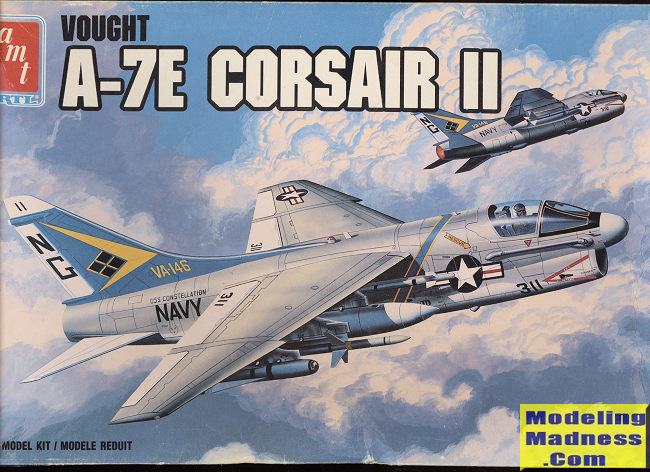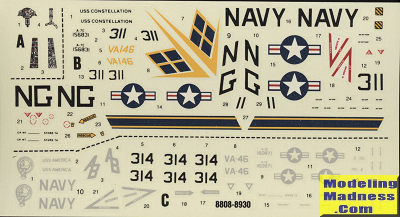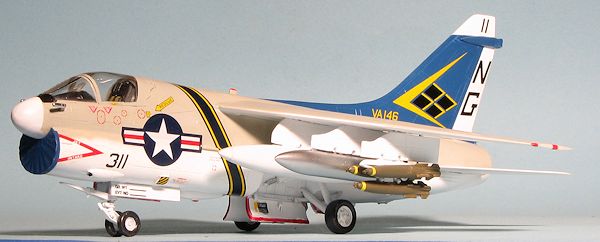
AMT/ERTL 1/72 A-7E Corsair II
| KIT #: | 8808 |
| PRICE: | $7.00 on the used kit market |
| DECALS: | Two options |
| REVIEWER: | Scott Van Aken |
| NOTES: | Reboxed ESCI kit. |

| HISTORY |
The LTV A-7 Corsair II is an American carrier-capable subsonic light attack aircraft manufactured by Ling-Temco-Vought(LTV) to replace the Douglas A-4 Skyhawk. Its airframe design was a somewhat smaller version of the supersonic Vought F-8 Crusader. The Corsair II initially entered service with the United States Navy (USN) during the Vietnam War. It was later adopted by the United States Air Force (USAF), including the Air National Guard, to replace the Douglas A-1 Skyraider and North American F-100 Super Sabre. The aircraft was also exported to Greece in the 1970s, and to Portugal in the late 1980s.
The Navy was sufficiently impressed with the increased power offered by the A-7D Spey engine used by the Air Force, and decided to use this engine for its own version of the Corsair II. The designation A-7E was assigned, and this version was to succeed the A-7B in production. However, there were delays in the deliveries of the TF41-A-2 engine specified for the A-7E, so the first 67 aircraft of the order were delivered with the TF30-P-5 engine. These aircraft had all of the other improvements planned for the A-7E, including the improved avionics and the M61 rotary cannon, and were re-designated A-7C after delivery.
The first Spey-powered A-7E flew for the first time on 9 March 1969. The A-7E differed from the USAF A-7D in retaining the probe-and-drogue midair refueling system of the earlier A-7A/B. It entered service in Southeast Asia in May 1970 with VA-146 and VA-147 deployed aboard USS America. The A-7E participated in numerous close-air support missions over both North and South Vietnam, the A-7E's state-of-the-art bombing and navigation system being particularly reliable and accurate. Most air wings operating Douglas A-4 Skyhawks and early A-7s were re-equipped with A-7Es. The A-7E participated in the mining of Haiphong harbor in 1972, and played a vital role in Operations Linebacker I and Linebacker II that led up to the formal end of US involvement in the Vietnam War on 24 January 1973.
On 15 May 1975, A-7E aircraft operating from USS Coral Sea, in conjunction with A-7D aircraft assigned to the 3d TFS at Korat RTAFB, provided air cover in what is considered the last battle of the Vietnam War, the recovery of SS MayagŁez after it was hijacked by Khmer Rouge gunboats. By the time the Mayaguez incident was over, three USAF Sikorsky CH-53 Sea Stallion helicopters had been shot down, two airmen, 11 Marines and two Navy Corpsmen had been killed in action and a further three Marines were missing in action. The type performed in combat in Grenada and against the Lybians on a couple of occasions with its last combat missions coming during Desert Storm after which the type was retired from fleet service.
| THE KIT |
Molded in a white plastic, this one has nicely engraved panel lines that would look good on any modern molding. There are no ejector pin marks on the inside of gear doors or on wheels or gear legs. Why ESCI could pull this off 30 years ago and some better known companies couldn't is beyond me. The cockpit tub is adequate with a bang seat, control stick, and instrument panel. One uses decals for instruments. A decal for the seat harness is also provided. I like having these included as they are better than nothing and not everyone wants to either make a harness or buy an aftermarket one.
Wings are a full upper surface with an insert for the lower inside. This insert has the two inner pylon areas already drilled out. The outer pylon is a butt join and all pylons are single piece moldings. To model folded wings, the builder will have to do some surgery. To my knowledge, the only 1/72 A-7 that can be built with folded wings is the Matchbox kit. For things under wings you have a pair of drop tanks, a TER and MER with lots of Mk 80 bombs to attach to them. You can also mount either Shrike or Maverick missiles, both of which are appropriate for the E model A-7. I should mention that there are fuselage mounted Sidewinders, but these were frequently not installed so not attaching the pylons is not a big deal.
Landing gear is well done and the wheels included are the slotted
variety which, I believe, are appropriate for the A-7E. ESCI apparently
did the right thing and included a sprue that is specific for the Navy version.
In it are all the different bits including fin and underside antennas, the
aforementioned wheels and a nose gear leg with the catapult bar to name most of
the bits. Finally, the clear bits include a separate windscreen and canopy so
you can model this open. Frankly, without an aftermarket cockpit, it would be
best to keep it closed as the cockpit is rather Spartan. It could also
 use a decent
bang seat and to my knowledge, no one makes one, though the A-4 seat is close.
use a decent
bang seat and to my knowledge, no one makes one, though the A-4 seat is close.
Instructions are well done providing FS 595 color references. The thick, glossy decals have markings for two planes. One is the box art scheme from VA-146 in the older glossy scheme. The other is a very subdued VA-46 scheme that is shown as being overall light gull grey. This is possible, but I'd look for photos just to be sure. Colors are provided in generic and FS595 references.
| CONCLUSIONS |
Not quite as nice as the Fujimi kits, but without the intake and general nose errors of the Hobby Boss kits, this is still one that the enthusiast should seek out. They are not difficult to find on the second hand market and are pretty inexpensive as things go. I built this kit once before though it was the Italeri boxing, and will happily build another.
| REFERENCES |
 https://en.wikipedia.org/wiki/LTV_A-7_Corsair_II
https://en.wikipedia.org/wiki/LTV_A-7_Corsair_II
January 2018
Copyright ModelingMadness.com. All rights reserved.
If you would like your product reviewed fairly and fairly quickly, please contact the editor or see other details in the Note to Contributors.
Back to the Main Page Back to the Review Index Page Back to the Previews Index Page